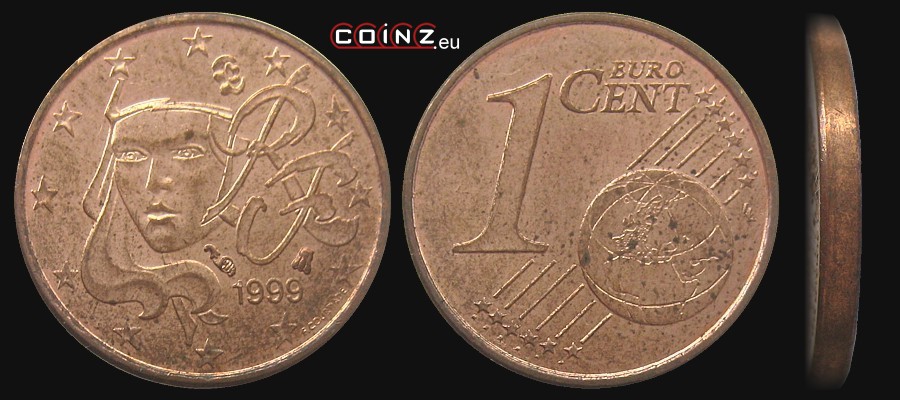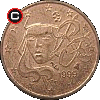1 euro cent FRANCE (from 1999)


| diameter: | weight: | thickness: | alloy: |
| 16.25 mm | 2.3 g | 1.67 mm | steel Cu-plated |
obverse:
in the coin centre personification of France - head of Marianne facing slightly left; on the right stylised letters: RF (RÉPUBLIQUE FRANÇAISE - French Republic); below year of issue; at the edge a ring of twelve five-pointed stars - symbol of the European Union
reverse:
edge:
plain
issue date:
1 I 2002
withdrawal date:
in circulation
designer:
Fabienne Courtiade (signature F.COURTIADE along the edge after year of issue in the obverse), Luc Luycx (initials LL on the right side of the globe in the reverse)
mint:
 La Monnaie de Paris (The Paris Mint), Pessac (mint mark above the first digits of year of issue in the obverse, above the last digits of year of issue privy mark of mint's director Pierre Rodier - bee - in years 1999-2000, or Gérard Buquoy - horseshoe - in years 2001-2002, or Serge Levet - heart - in 2003, or Hubert Larivière - horn - in years 2004-2010, or Yves Sampo - rosette - from 2011)
La Monnaie de Paris (The Paris Mint), Pessac (mint mark above the first digits of year of issue in the obverse, above the last digits of year of issue privy mark of mint's director Pierre Rodier - bee - in years 1999-2000, or Gérard Buquoy - horseshoe - in years 2001-2002, or Serge Levet - heart - in 2003, or Hubert Larivière - horn - in years 2004-2010, or Yves Sampo - rosette - from 2011)

mintage:
| 1999 | 794 016 000 | bee | + 35 000 in annual boxed sets |
| 2000 | 605 232 000 | bee | + 35 000 in annual boxed sets |
| 2001 | 300 646 580 | horseshoe | + 35 000 in annual boxed sets |
| 2002 | 110 000 | horseshoe | + 165 290 in annual boxed sets |
| 2003 | 160 017 000 | heart | + 242 342 in annual boxed sets |
| 2004 | 400 032 000 | horn | + 160 000 in annual boxed sets |
| 2005 | 240 206 000 | horn | + 120 000 in annual boxed sets |
| 2006 | 343 010 000 | horn | + 80 000 in annual boxed sets |
| 2007 | 320 142 000 | horn | + 60 000 in annual boxed sets |
| 2008 | 462 673 100 | horn | + 60 000 in annual boxed sets |
| 2009 | 437 320 000 | horn | + 60 000 in annual boxed sets |
| 2010 | 336 000 000 | horn | + 55 500 in annual boxed sets |
| 2011 | 320 000 000 | rosette | + 45 500 in annual boxed sets |
| 2012 | 359 000 000 | rosette | + 42 000 in annual boxed sets |
| 2013 | 275 000 000 | rosette | + 28 000 in annual boxed sets |
| 2014 | 365 000 000 | rosette | + 28 000 in annual boxed sets |
| 2015 | 287 000 000 | rosette | + 28 000 in annual boxed sets |
mint marks:
interesting facts:
last update: 12 VIII 2015
coins catalogue :: katalog monet :: münzkatalog :: catalogue de monnaies :: catálogo de monedas :: catalogo monete :: каталог монет :: κέρματα κατάλογος :: COINZ.eu
© 2010-2025 :: Adam Kubicki :: COINZ.eu :: All rights reserved.


